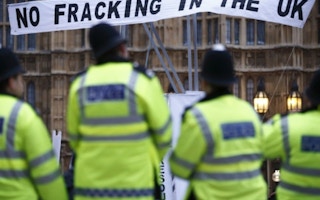In late June, the British Geological Survey announced the world’s largest shale-gas field. The Bowland Shale, which lies beneath Lancashire and Yorkshire, contains 50% more gas than the combined reserves of two of the largest fields in the United States, the Barnett Shale and the Marcellus Shale.
The United Kingdom has been reluctant to join the hydraulic-fracturing (or fracking) revolution. Yet tapping the Bowland Shale could reignite the UK economy and deliver huge cuts in CO2 emissions.
At the same time, the UK Parliament has approved stringent new measures to reduce carbon emissions by 2020, with the biggest CO2 cuts by far to come from an increase of more than 800% in offshore wind power over the next seven years. But offshore wind power is so expensive that it will receive at least three times the traded cost of regular electricity in subsidies – more than even solar power, which was never at an advantage in the UK. For minimal CO2 reduction, the UK economy will pay dearly.
This is just one example of current climate policy’s utter remove from reality – and not just in the UK. We are focusing on insignificant – but very costly – green policies that make us feel good, while ignoring or actively discouraging policies that would dramatically reduce emissions and make economic sense.
Consider the three standard arguments for a green economy: climate change, energy security, and jobs. As it turns out, fracking does better on all three.
Assuming complete success for the UK’s scheme, offshore wind power could produce more than 10% of the country’s electricity in 2020 and reduce its CO2 emissions by up to 22Mt, or 5%, per year. But the cost would also be phenomenal. The UK would pay at least $8 billion annually in subsidies to support this inherently inefficient technology.
Compare this to the opportunity of the Bowland Shale. If, by 2020, the UK could exploit its reserves there at just one-third the intensity of the exploitation of the Barnett and Marcellus Shales today, the outcome would be phenomenal.
Natural gas is much more environmentally friendly than coal, which continues to be the mainstay of electricity production around the world and in the UK. Gas emits less than half the CO2 per kWh produced, and it emits much lower amounts of other pollutants like NOx, SO2, black carbon, CO, mercury, and particulates. If the UK sold its shale gas both domestically and abroad to replace coal, it could reduce local air pollution significantly and reduce global carbon emissions by 170Mt, or more than a third of UK carbon emissions. At the same time, instead of costing $8 billion per year, shale-gas production would add about $10 billion per year to the UK economy.
Likewise, it is often argued that the green economy will increase energy security, as green resources will leave countries less dependent on fossil-fuel imports. But even much higher supplies of wind power would improve security only marginally, because the UK would still have to import just as much oil (wind replaces mostly coal, rarely oil) and much of its gas, leaving it dependent on Russia. For countries closer to Russia’s sphere of influence, like Poland and Ukraine, this dependence becomes palpable.
And yet the UK could improve its energy security dramatically, because it has enough gas reserves to cover roughly the entirety of its gas consumption for a half-century or more. Moreover, increased UK production would lower world prices, making countries with fewer or no shale-gas resources safer. And, of course, any country that is $10 billion richer, rather than $8 billion poorer, will have a better chance to handle future problems.
Finally, green-economy advocates promise a surfeit of green jobs. But economic research convincingly shows that while subsidies can buy extra jobs, they eventually have to be financed with increased taxes, costing an equal number of jobs elsewhere.
In comparison, shale gas in the US has created an estimated 600,000 jobs that are generating about $100 billion in added GDP and almost $20 billion in public revenue.
Current global climate policy is unsustainable; the UK’s commitment to boosting offshore wind power is only the latest example. Distressed economies cannot afford to pay more than $350 to avoid each ton of CO2, which could be cut on the European market for about 50 times less. Shale gas could cut the cost of reducing CO2 seven times more while actually helping Europe’s ailing economy.
Though it is not the ultimate solution, shale gas is greener. With good regulation, during the coming decade it can do the most good worldwide in terms of cutting CO2 emissions and improving living conditions. Mindless subsidies that we cannot afford will not create a green economy; what will is investment in research and development to bring down costs, so that green energy eventually can outcompete gas.
This post originally appeared here. Bjørn Lomborg, is an adjunct professor at the Copenhagen Business School, founded and directs the Copenhagen Consensus Center. He is the author of The Skeptical Environmentalist and Cool It.











